While battleships had carried torpedoes since the earliest days of underwater weaponry, it wasn't until the world wars that they were properly tested in battle, and even then, they were only used on a handful of occasions.1
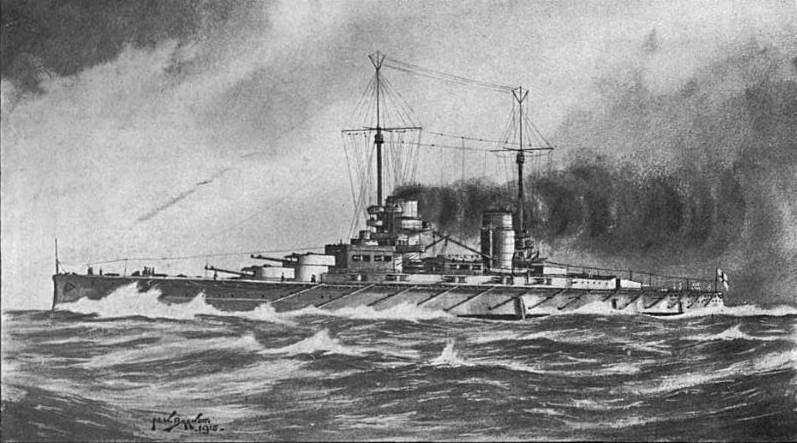
SMS Lutzow
At Jutland, both sides fired only a handful of torpedoes from their capital ships. The British battleships used 5, with the battlecruisers firing 8, while the German battleship Konig fired one, and their battlecruisers fired a total of 7.2 None of these appear to have hit, as most were fired at extreme range. The battlecruiser Lutzow did provide a graphic demonstration of the vulnerability of the torpedo flat to damage when hers was opened to the sea by a pair of 12" shells. It flooded almost instantly, and poor watertight design and maintenance quickly spread water throughout most of the forward part of the ship, ultimately leading to Lutzow’s loss.
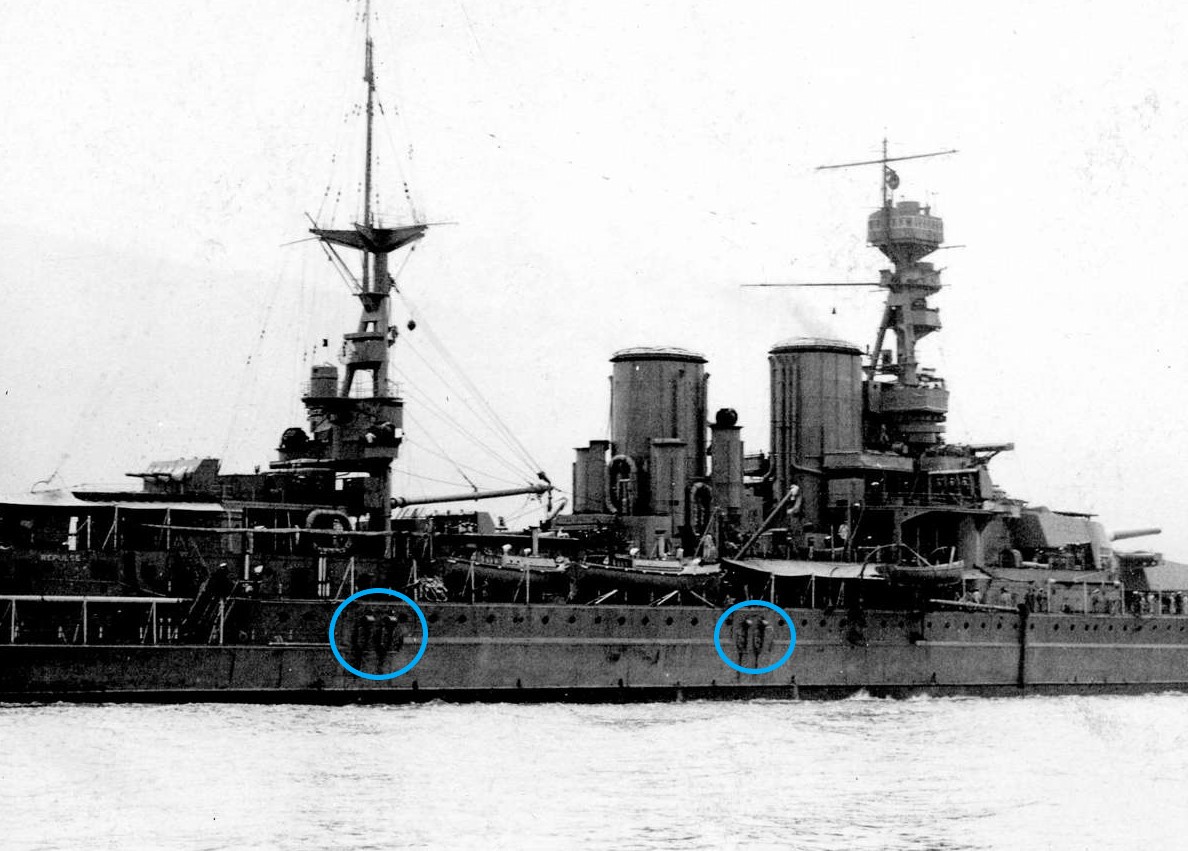
HMS Repulse shows her torpedo tubes
Despite its less-than-spectacular performance at Jutland and the danger posed by torpedo flats, the battleship torpedo survived WWI surprisingly well. In the aftermath of the battle, the British actually moved to fit their battlecruisers with more above-water tubes, believing that the faster battlecruisers would be able to get into firing position effectively, while their torpedoes could go some way to compensate for the ineffective shells the British were saddled with. In 1918, Repulse and Renown, originally built with two underwater tubes, were refitted with eight additional above-water tubes. The warheads were protected by a special armored mantlet, which would protect them from anything except a direct hit by a heavy-caliber shell. Usually, the torpedoes were stored with the warhead inside the 2-3" mantlet and the rest of the torpedo sticking out from behind it.
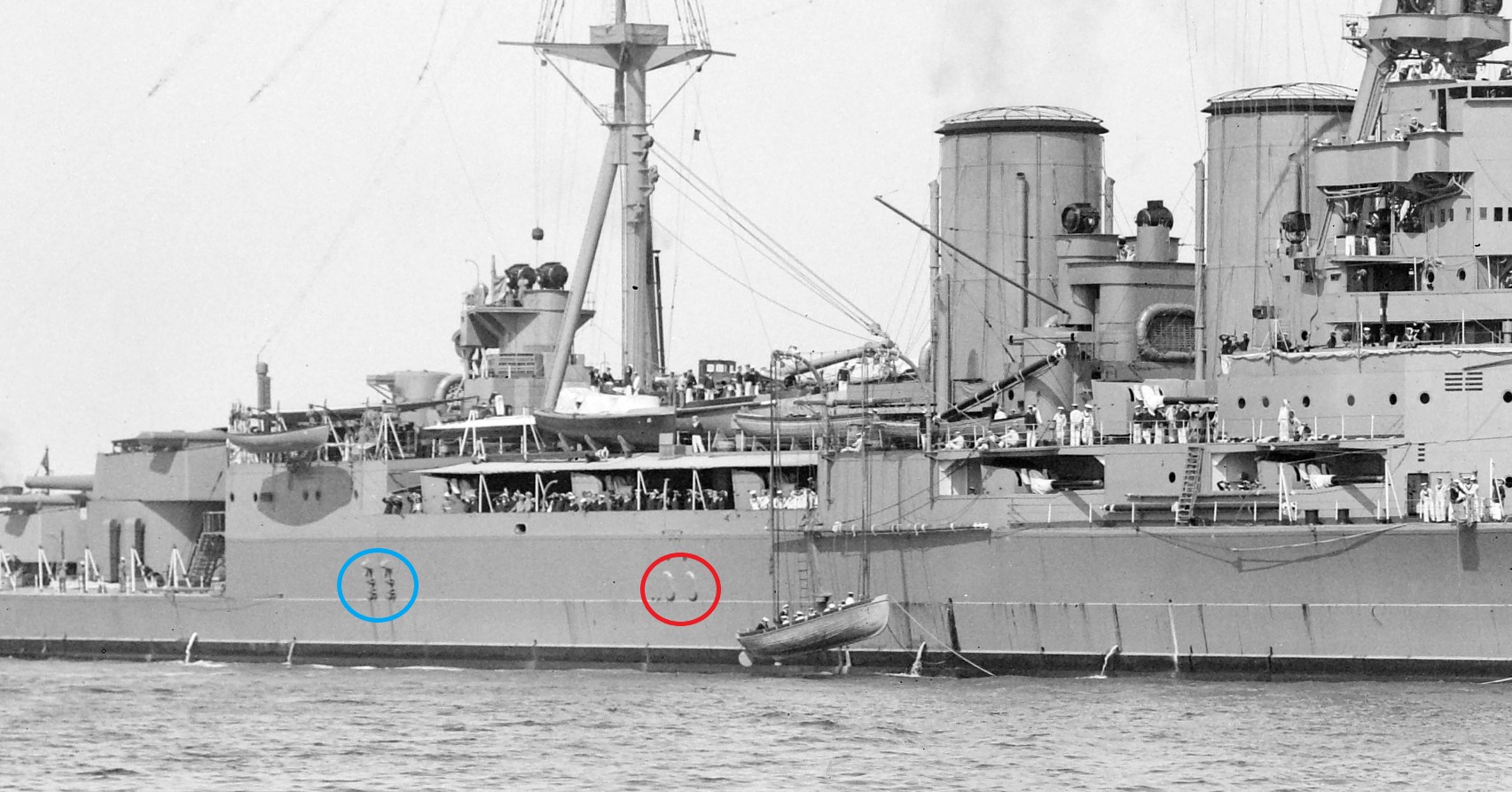
HMS Hood. The installed tubes can be seen aft, circled in blue, while the blanking covers for the other pair are circled in red.
HMS Hood was originally designed with a single twin underwater torpedo room, but when redesigned in the aftermath of Jutland, she was also to be given 8 above-water torpedo tubes,3 despite the protests of Director of Naval Construction Eustace Tennyson d'Eyncourt. d'Eyncourt pointed out that they were located directly over the ship's main strength girder, and could break the ship in half if they were set off. Ultimately, only four were fitted to Hood as completed, and they were initially labeled as "peacetime only" fittings in view of the danger they posed to the ship. Initially, the plan had been to provide them with 5" armor, but the need to increase deck protection meant that they were unprotected. In 1929, the armor was finally installed and the above-water tubes approved for wartime use. The underwater torpedoes were deleted during a refit in 1937, but the above-water torpedo tubes were retained. Hood’s destruction immediately raised suspicions that the torpedoes had been responsible, but they were ultimately ruled out by the investigation, a finding confirmed by later analysis and inspection of the wreck.
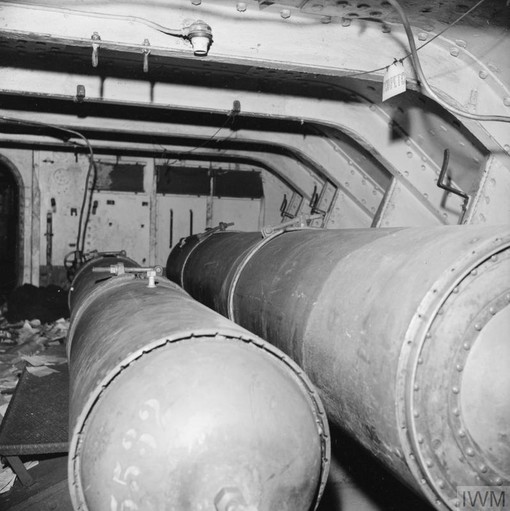
The torpedo flat of the former German battlecruiser Goeben, later the Turkish Yavuz
Postwar, most navies began to doubt the case for torpedoes aboard their battleships.4 The danger posed by the torpedo flats had been illustrated not only by the loss of Lutzow, but by the effects of a mine on the German Baden during Operation Albion. Both her bow flat and the forward broadside flat were opened to the sea, letting 1,000 tons of water onboard, and the damage was worsened by the explosion of 12 air accumulators in the flats, where the compressed air for the torpedoes was stored. This ultimately led to the deletion of the torpedo tubes from Baden and her sister Bayern, reportedly on the Kaiser's orders. Battleship torpedoes had also had a rather unimpressive record in combat, and as a result most nations turned towards above-water tubes, then abandoned torpedoes entirely. The early American dreadnoughts lost their torpedoes during their refits in the mid-20s, primarily due to the need to fit better underwater protection. Initially, the plan was to replace them with above-water tubes, but this was discarded due to the danger posted by the warheads. Later ships didn't have this problem, but by the 30s, removal of torpedoes was standard practice during refits.
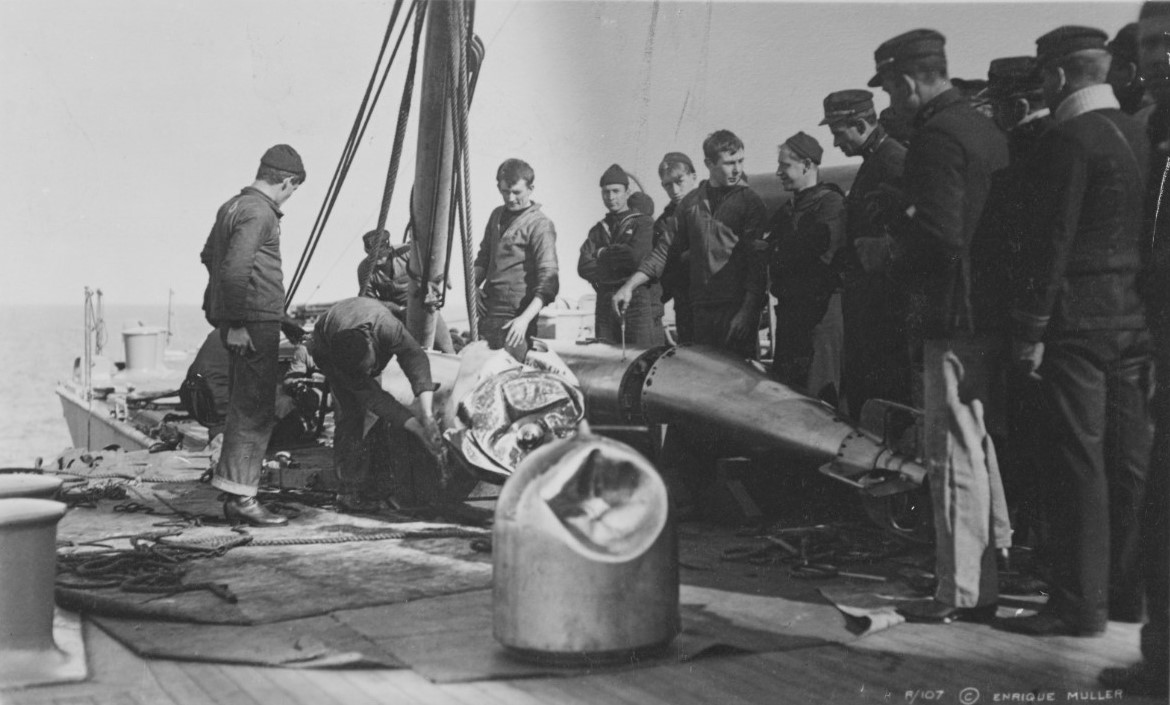
A torpedo on the deck of the American battleship Florida. The object in the foreground is probably a practice warhead, dented by running up against some obstacle.
The only country to hold out against this trend was Britain, whose interest in underwater weapons for their battlefleet would last right up until the end of the dreadnought era. We'll take a look at their part in all of this next time.
1 Before I began researching this section, I believed the common lore in naval circles that no battleship torpedoes were used during WWI. The earliest reference I found to this was in Breyer's 1974 book, which is dismissive of the whole idea of battleship torpedoes. ⇑
2 John Campbell, in his seminal work on the battle, speculates that more may have been fired given the number of torpedoes embarked on the capital ships of the fleet. Norman Friedman has suggested that British torpedo use was limited because there was a lot of overlap between gunnery and torpedo personnel, and they were obviously busy with the guns. ⇑
3 This was partially because there wasn't room for additional underwater tubes due to the size of Hood’s power plant, and partially because there was serious concern about how well underwater launch would work at the high speeds Hood was capable of. It's worth pointing out that the American Lexingtons were originally designed with four submerged and four above-water tubes, presumably for similar reasons. ⇑
4 Another issue, discovered by the British in 1917, was that it was very possible for a battle line's torpedoes to threaten other ships in the battle line, depending on maneuvers. I'm not sure of the exact details, but this accounted for some of the emphasis shift to destroyer torpedoes. I'm also confused as to why the RN remained the main proponent of battleship torpedoes. It might have been a matter of the much shorter battle lines after the Washington Treaty. ⇑

Comments
This might be the most beautiful example of ludicrous bureaucratic consensus that I've ever read.
I was going to comment on that too! Absolutely beautiful.
Do you know the origin of the term "torpedo flat"? Is it possibly the same as the UK term for single floor apartments?
@Echo
I don't know that, unfortunately. It's possible, as it was usually on a single level, but I don't have any definite sources. (Seriously, what's posted here is very close to 100% of what I learned during several weeks of research, except for Norman Friedman's analysis of British torpedo tactics, which ran several pages.) I do know that "flat" is also used for "powder flat" and "projectile flat" , and I'd assume that there was a connection there, but the terms are common on both sides of the Atlantic, so I find a connection to such a specifically British term a bit unlikely.
@cassander & @echo,
I don't know. It COULD be "ludicrous bureaucratic consensus", a compromise position that tries to be all things to all men, and ends up useless to all.
BUT, it could also be a perfectly reasonable position, depending on the unwritten second half of the sentence.
Was it: “peacetime only” fittings, not to be used in war, just for fun.
Or “peacetime only” fittings, not to be used in war, until we've got enough experience and development to use them safely and effectively.
You could interpret it each way, and the second way seems a perfectly legitimate to me.
I'm trying to understand why battleships would carry torpedoes in the first place. Battleships are first of all designed to fight other battleships. For that purpose they carry some of the largest guns in existence, with effective ranges of more than ten miles. One would expect battleship duels to be decided at those ranges, well before the ships get close enough to exchange torpedoes.
@Doctorpat
It's the first one. The plan at the time was basically to use it for practice/tactical development, and then presumably offload the torpedoes if hostilities broke out. Note that Repulse and Renown carried similar tubes, which were considered wartime fittings. Hood's got changed over when the armor was fitted. My language there is a bit confusing in retrospect.
@Johan
Throughout most of the period 1900-1915, increased torpedo range was the driver of improvements in gunnery range. So it wasn't fitting a long-range ship with short-range weapons. And for much of this time, British doctrine at least had the battle fleet operating independently of the destroyers, which would patrol off enemy bases to kill torpedo boats as they came out, and make independent attacks on the enemy fleet.
@Doctorpat
I read it as the former. The latter is more reasonable in theory but the trouble with the torpedoes was that they are a bunch of explosives right above a main girder that could be set off by enemy fire and destroy the ship. No amount of experience is going to change the physics of that.
Yeah, that girder thing is the killer.